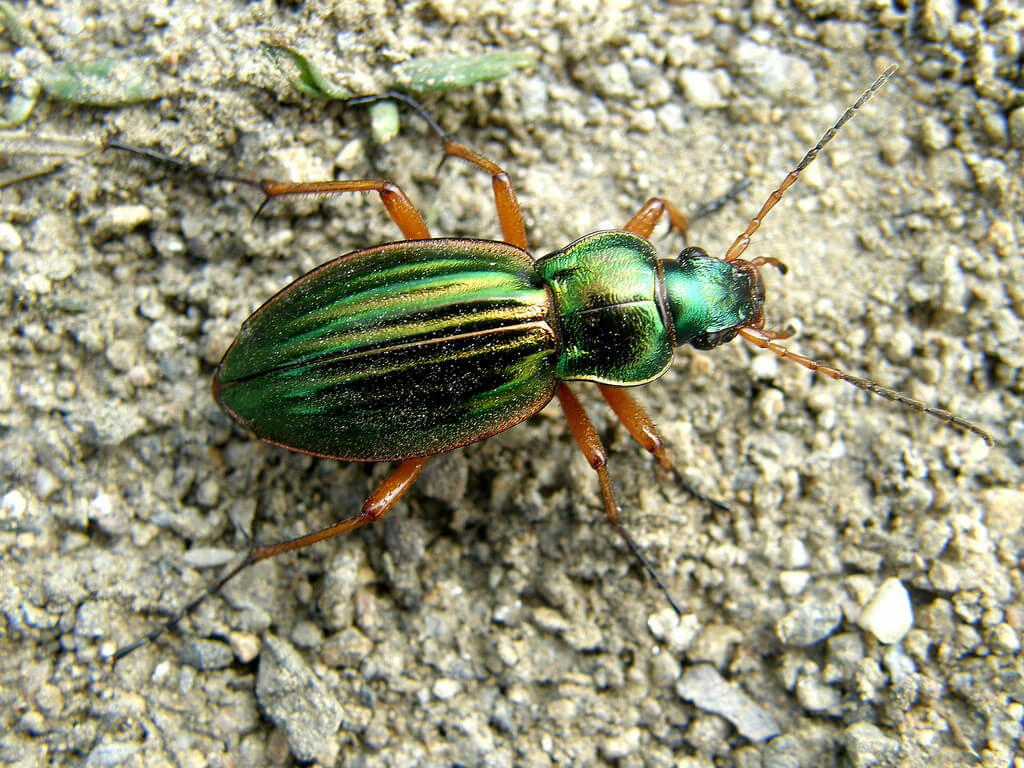5 Curious Aspects of the Golden Ground Beetle


Written and verified by the veterinarian and zootechnician Sebastian Ramirez Ocampo
The Carabus auratus, or golden ground beetle, is native to central and western Europe. It’s nocturnal, and is found mainly in gardens, on crops, and in forests.
It has a preference for clay and loam soils, where it hides under stones and tree trunks. Discover below five curious and interesting facts about this wonderful insect.

5 curious facts about the golden ground beetle
1. It has a powerful armor
The golden ground beetle is between 17 and 20 millimeters (3 to 4 inches) long in its adult stage. It’s mainly characterized by its thick and powerful thoracic shield, which is composed of the carbohydrate called chitin, which forms a large part of the exoskeletons of existing insects on the planet.
Likewise, its carapace is a mixture of green and metallic gold colors, an aspect that gives it its name. On the other hand, even though it has wings, this beetle can’t fly because they are very rudimentary.
2. It creates camps
To ensure its survival, the golden ground beetle establishes a series of camps or safe zones where it lives and reproduces. It only leaves these to feed and only moves within a radius of 70 meters (230 feet) from its initial base.
On the other hand, its life cycle, which lasts approximately two years, includes the egg, larva, pupa and adult phases, which generally emerge in autumn.
3. It’s a biological controller
Like other insect pest predators, this beetle has been used as an ally by agricultural producers in different parts of the world. Such is the case in the United States, where it was introduced to control the gypsy moth (Lymantria dispar) and the brown-tailed lizard butterfly (Euproctis chrysorrhoea), which cause great economic losses in this sector of the economy.
4. It’s a very voracious insect
In addition to feeding on lepidopterans such as butterflies and moths, this insect is also a predator of other pests such as slugs, snails, earthworms, and other beetles harmful to agriculture such as potato and cucumber beetles. Such is its voracity that it can consume up to 130% of its body weight per day.
It’s a very active hunter, as it chases its prey until it catches them with its jaws, then applies a digestive secretion to them and devours them.
5. It’s also a weed controller

According to several investigations, the golden ground beetle could be more beneficial to agricultural crops than previously thought. In addition to being a predator of several pests that are harmful to crops, this insect also consumes seeds and weeds present in the plantations. In this way, it prevents the growth of plants considered weeds by absorbing nutrients necessary for the growth of plant species in production.
Thanks to this, using them in agriculture would reduce the use of pesticides, insecticides, and other industrial chemicals, which are not very beneficial for biodiversity in different ecosystems. It’s recommended to leave strips of uncut grass every 70 meters (230 feet) to attract this beetle to crops.
All cited sources were thoroughly reviewed by our team to ensure their quality, reliability, currency, and validity. The bibliography of this article was considered reliable and of academic or scientific accuracy.
- Lewis J, Webster R, McAlpine D. First Occurrence in Canada of Carabus auratus L. (Coleoptera: Carabidae), an Adventive Ground Beetle of European Origin. The Coleopterists Bulletin. 2015;69:264–6.
- Sander A-C, Purtauf T, Wolters V, Dauber J. Landscape genetics of the widespread ground-beetle Carabus auratus in an agricultural region (vol 7, pg 555, 2006). Basic and Applied Ecology. 2006;7:555-64.
- Bursztyka P, Saffray D, Lafont-Lecuelle C, Brin A, Pageat P. Chemical compounds related to the predation risk posed by malacophagous ground beetles alter self-maintenance behavior of naive slugs (Deroceras reticulatum). PloS one. 2013;8(11):e79361.
This text is provided for informational purposes only and does not replace consultation with a professional. If in doubt, consult your specialist.